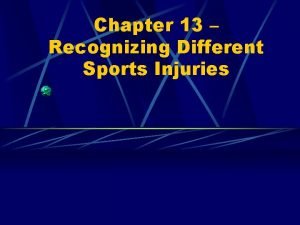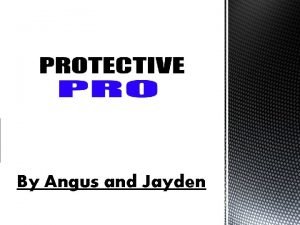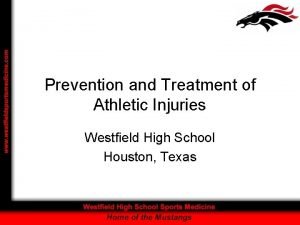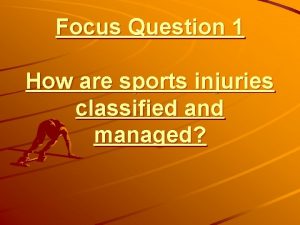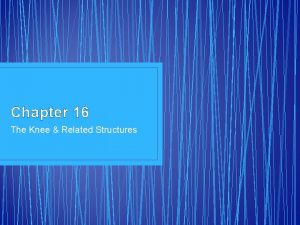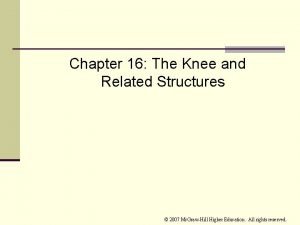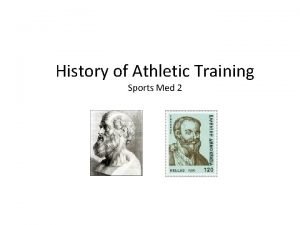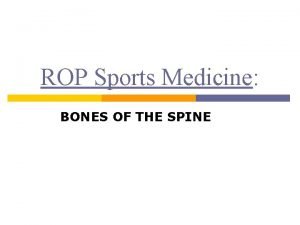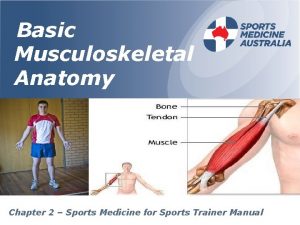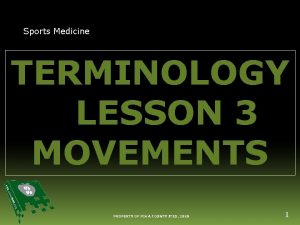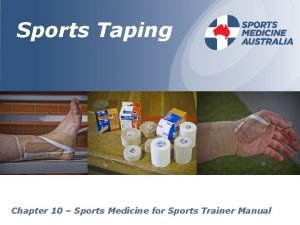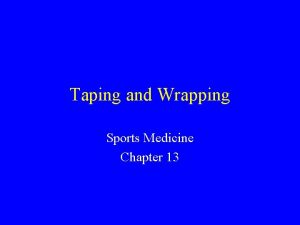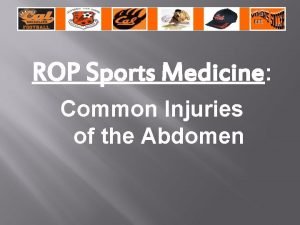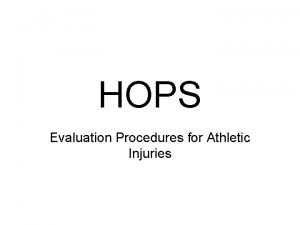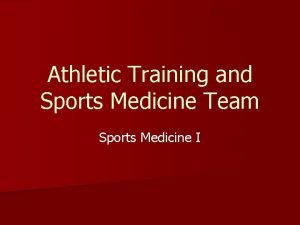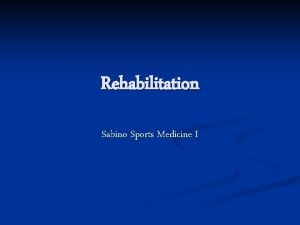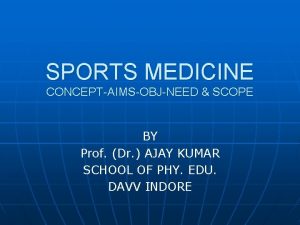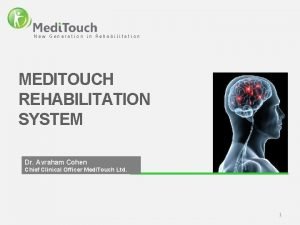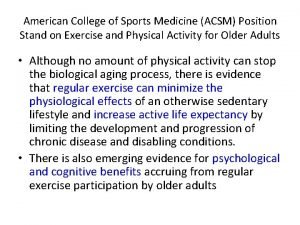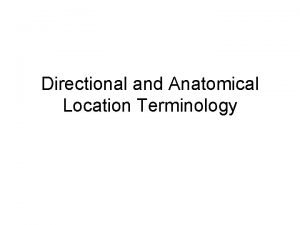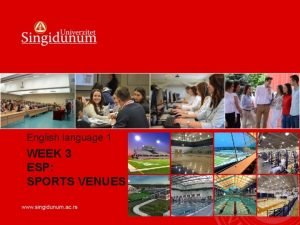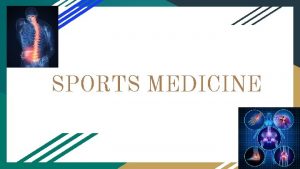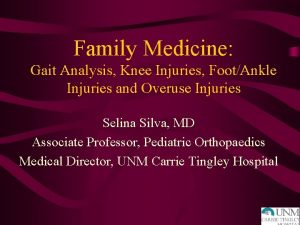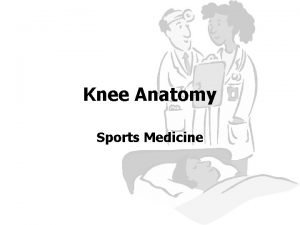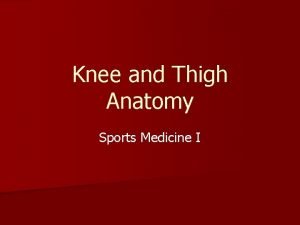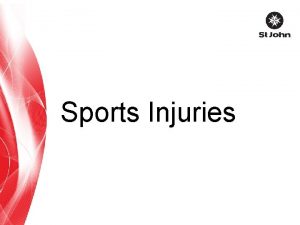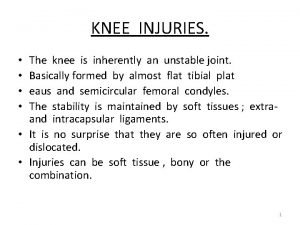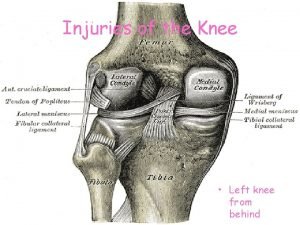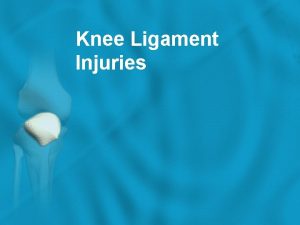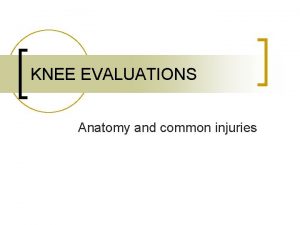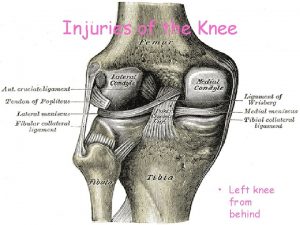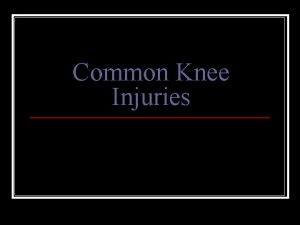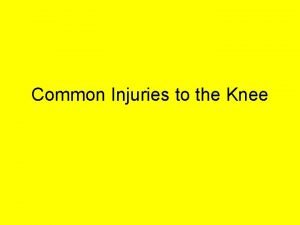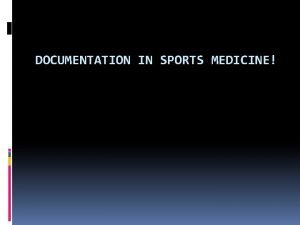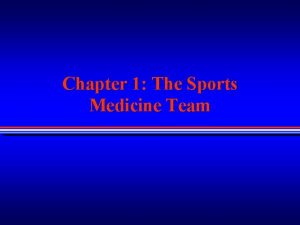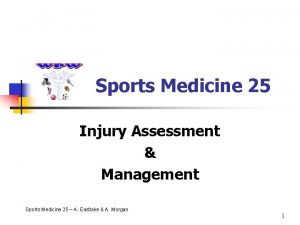Knee Injuries Sports Medicine 2 Knee Structures n























- Slides: 23

Knee Injuries Sports Medicine 2

Knee Structures n n Hinge Joint Stability comes from ligamentous support Femur, tibia, fibula, patella Menisci ~ 2 oval fibrocartilages


Ligaments n n ACL ~ Prevents the tibia from moving anteriorly or the femur from moving posteriorly PCL ~ Prevents posterior movement of the tibia on the femur, hyperextension MCL ~ Prevents valgus motion LCL ~ Prevents varus force


ACL Tears n n n Cause: Direct lateral or valgus blow with the knee flexed and tibia externally rotated, lower leg rotated with the foot planted, or flexion deceleration injury S/S: Hears/feels a ‘pop’ in the knee followed by immediate disability. Laxity of joint. TX: RICE n n n Surgery Rehabilitation ST: Anterior Drawer test, Lachman test

Normal ACL Torn ACL Restructured ACL

MCL Tears n n n Cause: Result of a medially directed valgus force from lateral side or from external rotation of the tibia S/S: Swelling, point tenderness, laxity on the medial side TX: RICE n n Crutches if unable to walk Bracing Surgery worse case ST: Valgus Stress Test, anterior drawer test



LCL Tears n Cause: Result of a laterally directed varus force from the medial side or from internal rotation of the tibia. q n n “Rarely ever will you have an isolated LCL tear” S/S: Pain and tenderness over the ligament, swelling, effusion, joint laxity TX: RICE n n Crutches if unable to walk Surgery if bad enough Brace ST: Varus Stress Test

PCL Tears n n n Cause: A full weight bearing fall on a hyper flexed knee. Dashboard injury S/S: Feels a ‘pop’ in the back of the knee. Tenderness and little swelling in popliteal fossa. Laxity may be noted. TX: RICE n n Quadricep strengthening on non-operative knees Surgery in highly active Brace ST: Posterior Drawer test

Meniscal Tear n n Cause: A weight bearing combined with a rotational force while extending of flexing the knee. Medial more common than lateral. Acute vs. Chronic S/S: Effusion on joint line, loss of motion, joint locking, and pain when squatting. TX: RICE n n n quad sets Surgery possible ST: Mc. Murray’s, Apley’s compression test


Meniscal Blood Supply

Patellar Tendonitis n n n Cause: Jumping, kicking, or running. S/S: Vague pain indicated, tenderness around bottom of patella, Point tenderness over tibial tuberosity TX: RICE (ice cups) n n NSAIDS Cho-pat strap Rehabilitation ST: Strength test, ROM test

Osgood-Schlatter’s Disease n n n Cause: common in immature athletes. Repeated pull of the patellar tendon at the tibial tubercle. S/S: Swelling, hemorrhage, and gradual degeneration of tubercle (causing deformity) TX: Conservative: RICE (ice cups) n n n Out for 6 months to 1 year Rehabilitation ST: X-Ray


Larsen-Johansson Disease n Same as Osgood-Schlatter Disease but occurs at inferior pole of patella


Patellar Tendon Rupture n Cause: Sudden powerful contraction of quads with weight of the body applied to affected leg q n n ***Steroid injections to this area increase likelihood of rupture S/S: Patella moves upward, noticeable defect, and athlete cannot extend knee TX: Conservative: Surgical repair n n NSAIDS ST: X-Ray, MRI


Chondromalacia Patella n n Cause: wearing away of articular cartilage on the posterior aspect of patella S/S: Pain while walking or deep bending n n n TX: RICE n n n Going up stairs Crepitation Avoid painful activities Rhb NSAIDS Surgery ST: History, Clarks sign, Patella grind test
 Chapter 11 assessment and evaluation of sports injuries
Chapter 11 assessment and evaluation of sports injuries Chapter 13 worksheet recognizing different sports injuries
Chapter 13 worksheet recognizing different sports injuries Sports injuries angus, on
Sports injuries angus, on Westfield sports injuries
Westfield sports injuries How are sports injuries classified and managed
How are sports injuries classified and managed Chapter 16 worksheet the knee and related structures
Chapter 16 worksheet the knee and related structures Chapter 16 worksheet the knee and related structures
Chapter 16 worksheet the knee and related structures Athletic training sports medicine
Athletic training sports medicine Rop sports medicine
Rop sports medicine Chapter 2 sports medicine
Chapter 2 sports medicine Sports medicine terminology
Sports medicine terminology Chapter 8 worksheet bandaging and taping
Chapter 8 worksheet bandaging and taping Wrist taping athletic training
Wrist taping athletic training Rop sports medicine
Rop sports medicine Hops definition sports medicine
Hops definition sports medicine Sports medicine umbrella
Sports medicine umbrella Meditouch sports medicine
Meditouch sports medicine Sports medicine careers
Sports medicine careers Scope of sports medicine
Scope of sports medicine Meditouch israel
Meditouch israel Hops in sports medicine
Hops in sports medicine What does acsm stand for
What does acsm stand for Mediolateral axis
Mediolateral axis Esp sports medicine
Esp sports medicine

